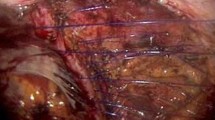Abstract
Introduction
Incisional hernias of the flank are rare with scattered case reports regarding the feasibility of laparoscopic treatment. Treatment can be technically challenging due to patient positioning and adequate mesh overlap and fixation. The aim of this study is to describe the surgical technique and present outcomes of the largest known case series of laparoscopic repair of flank hernia.
Methods
A retrospective chart review was performed from April 2002 to August 2006 at two university hospitals utilizing three surgeons’ experience. All patients who underwent a laparoscopic repair of a flank hernia were identified and reviewed with regards to short-term outcomes.
Results
Twenty-seven patients were identified with incisional flank hernia treated laparoscopically. Average defect size was 188 cm2 repaired with an average mesh size of 650 cm2. Mean operating room (OR) time was 144 min and mean length of stay (LOS) was 3.1 days. There were two reoperations within the cohort: one for a new, unrelated midline hernia 7 months after repair of the initial flank hernia and one for chronic pain with removal of a previously placed polypropylene mesh in the subcutaneous tissue of the abdominal wall. Neither patient had failure of the laparoscopic flank hernia repair. Two other patients were conservatively treated for chronic pain. Mean follow-up was 3.6 months.
Conclusions
In the laparoscopic repair of flank hernias adequate retroperitoneal dissection and wide mesh overlap is imperative. Laparoscopic repair can be performed safely and effectively with good short-term outcomes.




Similar content being viewed by others
References
Maeda K, Kanehira E, Shinno H, Yamamura K (2003) Laparoscopic tension-free hernioplasty for lumbar hernia. Surg Endosc 17:1497
Delgado MS, Urena MAG, Garcia MV, Marquez GP (2002) La eventracion lumbar como complicacion de la lumbotomia por el flanco: revisio de nuestra serie. Actas Urol Esp 26:345–350
Sakarya A, Aydede H, Erhan MY, Kara E, Ilkgul O, Yavuz C (2003) Laparoscopic repair of acquired lumbar hernia. Surg Endosc 17:1494
Burick A, Parascandola S (1996) Laparoscopic repair of a traumatic lumbar hernia: a case report. J Laparoendoscopic Surg 6:259–262
Arca M, Heniford T, Pokorny R, Wilson M, Mayes J, Gagner M (1998) Laparoscopic repair of lumbar hernias. J Am Coll Surg 187:147–152
Moreno-Egea A, Torralba-Martinez JA, Morales G, Fernandez T, Girela E, Aquayo-Albasini JL (2005) Open vs laparoscopic repair of secondary lumbar hernias: a prospective nonrandomized study. Surg Endosc 19:184–187
Author information
Authors and Affiliations
Corresponding author
Rights and permissions
About this article
Cite this article
Edwards, C., Geiger, T., Bartow, K. et al. Laparoscopic transperitoneal repair of flank hernias: a retrospective review of 27 patients. Surg Endosc 23, 2692–2696 (2009). https://doi.org/10.1007/s00464-009-0477-4
Received:
Accepted:
Published:
Issue Date:
DOI: https://doi.org/10.1007/s00464-009-0477-4




